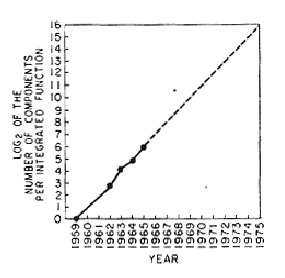CSC/ECE 506 Spring 2012/1b as
What is Moore's Law?

Moore's law, named after Gordon Moore, co-founder of Intel, states that the number of transistors that can be placed on an integrated circuit will double approximately every two years<ref>http://www.computerhistory.org/semiconductor/timeline/1965-Moore.html</ref>. The original prediction in 1965 stated a doubling every 12 months, but in 1975, after microprocessors were introduced that were less dense he slowed the rate of doubling to it's current state of two years <ref>http://arstechnica.com/hardware/news/2008/09/moore.ars</ref>. Instead of giving an empirical formula predicting the rate of increase, Moore instead used prose, graphs, and images to convey these predictions and observations to the masses. This in some ways increased the staying power of Moore's law, allowing the industry to use it as a benchmark of success and a measurable determination of their success. Virtually all digital devices are in some way fundamentally linked to the growth set in place by Moore's law.<ref>http://en.wikipedia.org/wiki/Moore's_law</ref>
The lesser known second law
Also know as Rock's law, this law is a direct consequence to Moore's law in that the cost to produce transistors on a chip may go down, these costs instead flow towards manufacturing, testing, and research and development. The law states that the cost of a semiconductor chip fabrication plant doubles ever four years. Simply put, in order for Moore's law to hold, Rock's law must also hold.<ref>http://en.wikipedia.org/wiki/Rock%27s_law</ref>
Moore's law, past to present

Reviewing data from the inception of Moore's law to the present shows that, consistent to Moore's prediction, the number of transistors on a chip has doubled approximately every 2 years. There are several contributing factors, that had they not been developed, could have slowed or plateaued Moore's law. Some of these are, the invention Dynamic random access memory (DRAM), complementary metal-oxide-semiconductor (CMOS), and the invention of the integrated circuit itself. Moore's law isn't only responsible for making larger and faster chips, but also smaller, cheaper, and more efficient ones as well.
| Processor | Transistor count | Date of introduction | Manufacturer | Process | Area |
|---|---|---|---|---|---|
| Intel 4004 | 2,300 | 1971 | Intel | 10 µm | 12 mm² |
| Intel 8008 | 3,500 | 1972 | Intel | 10 µm | 14 mm² |
| MOS Technology 6502 | 3,510 | 1975 | MOS Technology | 21 mm² | |
| Motorola 6800 | 4,100 | 1974 | Motorola | 16 mm² | |
| Intel 8080 | 4,500 | 1974 | Intel | 6 μm | 20 mm² |
| RCA 1802 | 5,000 | 1974 | RCA | 5 μm | 27 mm² |
| Intel 8085 | 6,500 | 1976 | Intel | 3 μm | 20 mm² |
| Zilog Z80 | 8,500 | 1976 | Zilog | 4 μm | 18 mm² |
| Motorola 6809 | 9,000 | 1978 | Motorola | 5 μm | 21 mm² |
| Intel 8086 | 29,000 | 1978 | Intel | 3 μm | 33 mm² |
| Intel 8088 | 29,000 | 1979 | Intel | 3 μm | 33 mm² |
| Intel 80186 | 55,000 | 1982 | Intel | ||
| Motorola 68000 | 68,000 | 1979 | Motorola | 4 μm | 44 mm² |
| Intel 80286 | 134,000 | 1982 | Intel | 1.5 µm | 49 mm² |
| Intel 80386 | 275,000 | 1985 | Intel | 1.5 µm | 104 mm² |
| Intel 80486 | 1,180,000 | 1989 | Intel | 1 µm | 160 mm² |
| Pentium | 3,100,000 | 1993 | Intel | 0.8 µm | 294 mm² |
| AMD K5 | 4,300,000 | 1996 | AMD | 0.5 µm | |
| Pentium II | 7,500,000 | 1997 | Intel | 0.35 µm | 195 mm² |
| AMD K6 | 8,800,000 | 1997 | AMD | 0.35 µm | |
| Pentium III | 9,500,000 | 1999 | Intel | 0.25 µm | |
| AMD K6-III | 21,300,000 | 1999 | AMD | 0.25 µm | |
| AMD K7 | 22,000,000 | 1999 | AMD | 0.25 µm | |
| Pentium 4 | 42,000,000 | 2000 | Intel | 180 nm | |
| Atom | 47,000,000 | 2008 | Intel | 45 nm | |
| Barton | 54,300,000 | 2003 | AMD | 130 nm | |
| AMD K8 | 105,900,000 | 2003 | AMD | 130 nm | |
| Itanium 2 | 220,000,000 | 2003 | Intel | 130 nm | |
| Cell | 241,000,000 | 2006 | Sony/IBM/Toshiba | 90 nm | |
| Core 2 Duo | 291,000,000 | 2006 | Intel | 65 nm | |
| AMD K10 | 463,000,000 | 2007 | AMD | 65 nm | |
| AMD K10 | 758,000,000 | 2008 | AMD | 45 nm | |
| Itanium 2 with 9MB cache | 592,000,000 | 2004 | Intel | 130 nm | |
| Core i7 (Quad) | 731,000,000 | 2008 | Intel | 45 nm | 263 mm² |
| Six-Core Xeon 7400 | 1,900,000,000 | 2008 | Intel | 45 nm | |
| POWER6 | 789,000,000 | 2007 | IBM | 65 nm | 341 mm² |
| Six-Core Opteron 2400 | 904,000,000 | 2009 | AMD | 45 nm | 346 mm² |
| 16-Core SPARC T3 | 1,000,000,000 | 2010 | Sun/Oracle Corporation|Oracle | 40 nm | 377 mm² |
| Core i7 (Gulftown) | 1,170,000,000 | 2010 | Intel | 32 nm | 240 mm² |
| 8-core POWER7 | 1,200,000,000 | 2010 | IBM | 45 nm | 567 mm² |
| z196 | 1,400,000,000 | 2010 | IBM | 45 nm | 512 mm² |
| Dual-Core Itanium 2 | 1,700,000,000 | 2006 | Intel | 90 nm | 596 mm² |
| Tukwila | 2,000,000,000 | 2010 | Intel | 65 nm | 699 mm² |
| Core i7 (Sandy Bridge-E) | 2,270,000,000 | 2011 | Intel | 32 nm | 434 mm² |
| Nehalem-EX | 2,300,000,000 | 2010 | Intel | 45 nm | 684 mm² |
| 10-Core Xeon Westmere-EX | 2,600,000,000 | 2011 | Intel | 32 nm | 512 mm² |
A quick primer on current manufacturing techniques
At the heart of this revolution is the computer chip, which can contain hundreds of millions of transistors on a silicon wafer the size of your fingernail. Inside your laptop there is a chip whose transistors can be seen only under a microscope. To make these chips, first a “stencil” is made containing the outlines of millions of transistors. This is placed over a silicone wafer containing many layers of silicon, which is sensitive to light. Ultraviolet light is then focused on the stencil, which then penetrates through the gaps of the stencil and exposes the silicon wafer. Then the wafer is bathed in acid, carving the outlines of the circuits and creating the intricate design of millions of transistors. Since the wafer consists of many conducting and semiconducting layers, the acid cuts into the wafer at different depths and patterns, so one can create circuits of enormous complexity.
One reason why Moore’s law has relentlessly increased the power of chips is because UV light can be tuned so that its wavelength is smaller and smaller, making it possible to etch increasingly tiny transistors onto silicon wafers. Since UV light has a wavelength as small as 10 nanometers (a nanometer is a billionth of a meter), this means that the smallest transistor that you can etch is about thirty atoms across. But this process cannot go on forever. At some point, it will be physically impossible to etch transistors in this way that are the size of atoms. Moore’s law will finally collapse when transistor sizes are reduced to the size of individual atoms. Currently, estimates predict that around 2020 or soon afterward, Moore’s law will gradually cease to hold true. Transistors will be so small that quantum theory or atomic physics takes over and electrons will leak out of the wires. For example, the thinnest layer inside a computer will be about five atoms across. At that size, quantum effects will become dominant and transistors will not function as they currently do without other technological advances.
References
<references/>